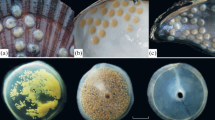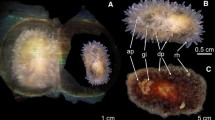Abstract
One can predict the major features of a muricid's life history from its adult size. Most adults do not grow, and juveniles of all species grow 1 to 2 mm/month, so that larger adults have had fonger juvenile periods. Larger females deposit larger egg capsules and, since each of these contains more eggs, their clutches are larger. Small females deposit several clutches each year, and thus have relatively large annual fecundities. However, large females live longer, so each spawns many more eggs in her life-time than would a smaller female. From 90 to 99% of the juveniles die within their first year. However hatchings of small species are much more likely to complete their first year; a newly hatched Urosalpinx cinerea is 25 times more likely to survive long enough to breed once than a newly hatched Ceratostoma foliatum (Gmelin, 1791).
Similar content being viewed by others
Literature Cited
Bertalanffy, L. von: Quantitative laws in metabolism and growth. Q. Rev. Biol. 32, 217–231 (1957).
Carriker, M. R.: Critical review of biology and control of oyster drills Urosalpinx and Eupleura. Spec. scient. Rep. U.S. Fish Wildl. Serv. (Fish.) 148, 1–150 (1955).
Cernorhorsky, W. O.: The radula, egg capsules and young of Murex torrefactus. Veliger 8, 231–233 (1965).
Chess, J. R. and R. J. Rosenthal: On the reproductive biology of Mitra idae. Veliger 14, 172–176 (1971).
Cole, H. A.: The American whelk tingle, Urosalpinx cinerea (Say) on British oysters beds. J. mar. biol. Ass. U.K. 25, 477–508 (1942).
Dayton, P. K.: Competition, disturbance, and community organization: the provision and subsequent utilization of space in a rocky intertidal community. Ecol. Monogr. 41, 351–389 (1971).
Deevey, E. S.: Life tables for natural populations of animals. Q. Rev. Biol. 29, 283–314 (1947).
Engle, J. B.: Growth of the oyster drill, Urosalpinx cinerea Say, feeding on four different food animals. Anat. Rec. 84, p. 505 (1942).
Feare, C. J.: Aspects of the ecology of an exposed shore population of dogwhelks, Nucella lapillus (L.). Oecologia (Berl.) 5, 1–18 (1970).
Federighi, H.: Studies on the oyster drill, Urosalpinx cinerea. Bull. Bur. Fish., Wash. 47, 85–115 (1931).
Fotheringham, N.: Life history patterns of the littoral gastropods Shaskyus festivus (Hinds) and Ocenebra poulsoni. Carpenter (Prosobranchia: Muricidae). Ecology 52, 742–757 (1971).
Frank, P. W.: Shell growth in a natural population of the turban snail, Tegula funebralis. Growth 29, 395–403 (1965).
Franz, D. R.: Population age structure, growth, and longevity of the marine gastropod, Urosalpinx cinerea Say. Biol. Bull. mar. biol. Lab., Woods Hole 140, 63–72 (1971).
Gadgil, M. and W. H. Bossert: Life historical consequences of natural selection. Am. Nat. 104, 1–24 (1970).
Griffith, C. W. and M. Castagna: Sexual dimorphism in oyster drills of Chincoteague Bay, Maryland-Virginia. Chesapeake Sci. 3, 215–217 (1962).
Hancock, D. A.: The biology and control of the American whelk tingle Urosalpinx cinerea (Say) on English oyster beds. Fishery Invest., Lond. (Ser. II) 22 (10), 1–66 (1959).
—: The ecology of the mulluscan enemies of the edible mollusc. Proc. malac. Soc. Lond. 34, 123–143 (1960).
Hanks, J. E.: The rate of feeding of the common oyster drill, Urosalpinx cinerea (Say) at controlled water temperatures. Biol. Bull. mar. biol. Lab., Woods Hole 112, 330–335 (1957).
Haydock, C. I.: An experimental study to control oyster drills in Tomales Bay, California. Calif. Fish Game 50, 11–28 (1964).
Hodder, V. M.: Fecundity of the Grand Bank haddock. J. Fish. Res. Bd Can. 20, 1465–1487 (1963).
Jónasson, P. M.: Population studies on Chironomus anthracinus. In: Proceedings of the Advanced Study Institute on Dynamics of Numbers in Populations (Oosterbeek, 1970), pp 220–231. Ed. by P. J. den Boer and G. R. Gradwell. Wageningen: Centre for Agricultural Publishing and Documentation 1971.
Laxton, J. H.: Shell growth in some New Zealand Cymatiidae (Gastropoda: Prosobranchia). J. exp. mar. Biol. Ecol. 4, 250–260 (1970).
Luckens, P. A.: Predation and intertidal zonation at Asamushi. Bull. biol. Stn Asamushi 14, 33–52 (1970).
Mackenzie, C. L.: Growth and reproduction of the oyster drill Eupleura caudata in the York River, Virginia. Ecology 42, 317–338 (1961).
Murdoch, W. W.: Population stability and life history phenomena. Am. Nat. 100, 5–11 (1966).
Paine, R. T.: The Pisaster—Tegula interaction: prey patches, predator food preference, and intertidal community structure. Ecology 50, 950–961 (1969).
Pianka, E. R.: On r and K selection. Am. Nat. 104, 592–597 (1970).
Phillips, B. F. and N. A. Campbell: A new method of fitting the Von Bertalanffy growth curve using date on the whelk Dicathais. Growth 32, 317–329 (1968).
Ricketts, E. F. and J. Calvin: Between Pacific tides (4th ed., revised by J. Hedgpeth), 614 pp. Stanford, California: Stanford University Press 1970.
Spight, T. M.: Patterns of change in adjacent populations of an intertidal snail, Thais lamellosa, 308 pp. Ph. D. Thesis, University of Washington 1972.
Spight, T. M., Temperature, hatchling complexity, and gastropod development. (In preparation).
Stauber, L. A.: Ecological studies on the oyster drill, Urosalpinx cinerea, in Delaware Bay, with notes on the associated drill, Eupleura caudata, and with practical consideration of control methods. Unpubl. Rep., Oyster Res. Lab., N.J. (Rutgers University Library of Science and Medicine, call no. SH 371.S8) (1943).
Sutherland, J. P.: Dynamics of high and low populations of the limpet, Acmaea scabra (Gould). Ecol. Monogr. 40, 169–188 (1970).
Thorson, G.: Reproductive and larval ecology of marine bottom invertebrates. Biol. Rev. 25, 1–45 (1950).
Tinkle, D. W. and R. E. Ballinger: Sceloporus undulatus: a study of the intraspecific comparative demography of a lizard. Ecology 53, 570–584 (1972).
—, H. M. Wilbur and S. G. Tilley: Evolutionary strategies in lizard reproduction. Evolution, Lancaster, Pa. 24, 55–74 (1970).
Williams, G. C.: Adaptation and natural selection, 307 pp. Princeton, New Jersey: Princeton University Press 1966.
Zijlstra, J. J.: Egg weight and fecundity in the North Sea herring (Clupea harengus). Neth. J. Sea Res. 6, 173–204 (1973).
Author information
Authors and Affiliations
Additional information
Communicated by J. Bunt, Miami
Rights and permissions
About this article
Cite this article
Spight, T.M., Birkeland, C. & Lyons, A. Life histories of large and small murexes (Prosobranchia: Muricidae). Mar. Biol. 24, 229–242 (1974). https://doi.org/10.1007/BF00391898
Accepted:
Issue Date:
DOI: https://doi.org/10.1007/BF00391898




